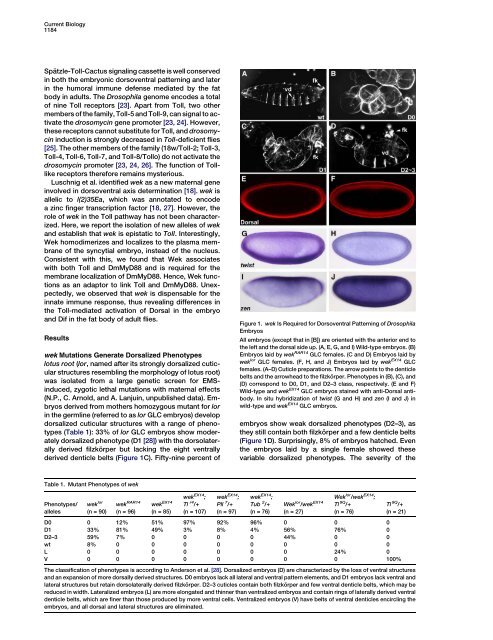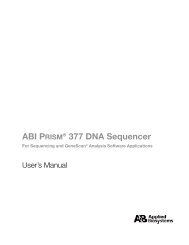Article Weckle Is a Zinc Finger Adaptor of the Toll Pathway in ...
Article Weckle Is a Zinc Finger Adaptor of the Toll Pathway in ...
Article Weckle Is a Zinc Finger Adaptor of the Toll Pathway in ...
Create successful ePaper yourself
Turn your PDF publications into a flip-book with our unique Google optimized e-Paper software.
Current Biology<br />
1184<br />
Spätzle-<strong>Toll</strong>-Cactus signal<strong>in</strong>g cassette is well conserved<br />
<strong>in</strong> both <strong>the</strong> embryonic dorsoventral pattern<strong>in</strong>g and later<br />
<strong>in</strong> <strong>the</strong> humoral immune defense mediated by <strong>the</strong> fat<br />
body <strong>in</strong> adults. The Drosophila genome encodes a total<br />
<strong>of</strong> n<strong>in</strong>e <strong>Toll</strong> receptors [23]. Apart from <strong>Toll</strong>, two o<strong>the</strong>r<br />
members <strong>of</strong> <strong>the</strong> family, <strong>Toll</strong>-5 and <strong>Toll</strong>-9, can signal to activate<br />
<strong>the</strong> drosomyc<strong>in</strong> gene promoter [23, 24]. However,<br />
<strong>the</strong>se receptors cannot substitute for <strong>Toll</strong>, and drosomyc<strong>in</strong><br />
<strong>in</strong>duction is strongly decreased <strong>in</strong> <strong>Toll</strong>-deficient flies<br />
[25]. The o<strong>the</strong>r members <strong>of</strong> <strong>the</strong> family (18w/<strong>Toll</strong>-2; <strong>Toll</strong>-3,<br />
<strong>Toll</strong>-4, <strong>Toll</strong>-6, <strong>Toll</strong>-7, and <strong>Toll</strong>-8/<strong>Toll</strong>o) do not activate <strong>the</strong><br />
drosomyc<strong>in</strong> promoter [23, 24, 26]. The function <strong>of</strong> <strong>Toll</strong>like<br />
receptors <strong>the</strong>refore rema<strong>in</strong>s mysterious.<br />
Luschnig et al. identified wek as a new maternal gene<br />
<strong>in</strong>volved <strong>in</strong> dorsoventral axis determ<strong>in</strong>ation [18]. wek is<br />
allelic to l(2)35Ea, which was annotated to encode<br />
a z<strong>in</strong>c f<strong>in</strong>ger transcription factor [18, 27]. However, <strong>the</strong><br />
role <strong>of</strong> wek <strong>in</strong> <strong>the</strong> <strong>Toll</strong> pathway has not been characterized.<br />
Here, we report <strong>the</strong> isolation <strong>of</strong> new alleles <strong>of</strong> wek<br />
and establish that wek is epistatic to <strong>Toll</strong>. Interest<strong>in</strong>gly,<br />
Wek homodimerizes and localizes to <strong>the</strong> plasma membrane<br />
<strong>of</strong> <strong>the</strong> syncytial embryo, <strong>in</strong>stead <strong>of</strong> <strong>the</strong> nucleus.<br />
Consistent with this, we found that Wek associates<br />
with both <strong>Toll</strong> and DmMyD88 and is required for <strong>the</strong><br />
membrane localization <strong>of</strong> DmMyD88. Hence, Wek functions<br />
as an adaptor to l<strong>in</strong>k <strong>Toll</strong> and DmMyD88. Unexpectedly,<br />
we observed that wek is dispensable for <strong>the</strong><br />
<strong>in</strong>nate immune response, thus reveal<strong>in</strong>g differences <strong>in</strong><br />
<strong>the</strong> <strong>Toll</strong>-mediated activation <strong>of</strong> Dorsal <strong>in</strong> <strong>the</strong> embryo<br />
and Dif <strong>in</strong> <strong>the</strong> fat body <strong>of</strong> adult flies.<br />
Results<br />
wek Mutations Generate Dorsalized Phenotypes<br />
lotus root (lor, named after its strongly dorsalized cuticular<br />
structures resembl<strong>in</strong>g <strong>the</strong> morphology <strong>of</strong> lotus root)<br />
was isolated from a large genetic screen for EMS<strong>in</strong>duced,<br />
zygotic lethal mutations with maternal effects<br />
(N.P., C. Arnold, and A. Lanju<strong>in</strong>, unpublished data). Embryos<br />
derived from mo<strong>the</strong>rs homozygous mutant for lor<br />
<strong>in</strong> <strong>the</strong> germl<strong>in</strong>e (referred to as lor GLC embryos) develop<br />
dorsalized cuticular structures with a range <strong>of</strong> phenotypes<br />
(Table 1): 33% <strong>of</strong> lor GLC embryos show moderately<br />
dorsalized phenotype (D1 [28]) with <strong>the</strong> dorsolaterally<br />
derived filzkörper but lack<strong>in</strong>g <strong>the</strong> eight ventrally<br />
derived denticle belts (Figure 1C). Fifty-n<strong>in</strong>e percent <strong>of</strong><br />
Figure 1. wek <strong>Is</strong> Required for Dorsoventral Pattern<strong>in</strong>g <strong>of</strong> Drosophila<br />
Embryos<br />
All embryos (except that <strong>in</strong> [B]) are oriented with <strong>the</strong> anterior end to<br />
<strong>the</strong> left and <strong>the</strong> dorsal side up. (A, E, G, and I) Wild-type embryos. (B)<br />
Embryos laid by wek RAR14 GLC females. (C and D) Embryos laid by<br />
wek lor GLC females. (F, H, and J) Embryos laid by wek EX14 GLC<br />
females. (A–D) Cuticle preparations. The arrow po<strong>in</strong>ts to <strong>the</strong> denticle<br />
belts and <strong>the</strong> arrowhead to <strong>the</strong> filzkörper. Phenotypes <strong>in</strong> (B), (C), and<br />
(D) correspond to D0, D1, and D2–3 class, respectively. (E and F)<br />
Wild-type and wek EX14 GLC embryos sta<strong>in</strong>ed with anti-Dorsal antibody.<br />
In situ hybridization <strong>of</strong> twist (G and H) and zen (I and J) <strong>in</strong><br />
wild-type and wek EX14 GLC embryos.<br />
embryos show weak dorsalized phenotypes (D2–3), as<br />
<strong>the</strong>y still conta<strong>in</strong> both filzkörper and a few denticle belts<br />
(Figure 1D). Surpris<strong>in</strong>gly, 8% <strong>of</strong> embryos hatched. Even<br />
<strong>the</strong> embryos laid by a s<strong>in</strong>gle female showed <strong>the</strong>se<br />
variable dorsalized phenotypes. The severity <strong>of</strong> <strong>the</strong><br />
Table 1. Mutant Phenotypes <strong>of</strong> wek<br />
Phenotypes/<br />
alleles<br />
wek lor<br />
(n = 90)<br />
wek RAR14<br />
(n = 96)<br />
wek EX14<br />
(n = 85)<br />
wek EX14 ;<br />
Tl r4 /+<br />
(n = 107)<br />
wek EX14 ;<br />
Pll 7 /+<br />
(n = 97)<br />
wek EX14 ;<br />
Tub 2 /+<br />
(n = 76)<br />
Wek lor /wek EX14<br />
(n = 27)<br />
Wek lor /wek EX14 ;<br />
Tl 9Q /+<br />
(n = 76)<br />
Tl 9Q /+<br />
(n = 21)<br />
D0 0 12% 51% 97% 92% 96% 0 0 0<br />
D1 33% 81% 49% 3% 8% 4% 56% 76% 0<br />
D2–3 59% 7% 0 0 0 0 44% 0 0<br />
wt 8% 0 0 0 0 0 0 0 0<br />
L 0 0 0 0 0 0 0 24% 0<br />
V 0 0 0 0 0 0 0 0 100%<br />
The classification <strong>of</strong> phenotypes is accord<strong>in</strong>g to Anderson et al. [28]. Dorsalized embryos (D) are characterized by <strong>the</strong> loss <strong>of</strong> ventral structures<br />
and an expansion <strong>of</strong> more dorsally derived structures. D0 embryos lack all lateral and ventral pattern elements, and D1 embryos lack ventral and<br />
lateral structures but reta<strong>in</strong> dorsolaterally derived filzkörper. D2–3 cuticles conta<strong>in</strong> both filzkörper and few ventral denticle belts, which may be<br />
reduced <strong>in</strong> width. Lateralized embryos (L) are more elongated and th<strong>in</strong>ner than ventralized embryos and conta<strong>in</strong> r<strong>in</strong>gs <strong>of</strong> laterally derived ventral<br />
denticle belts, which are f<strong>in</strong>er than those produced by more ventral cells. Ventralized embryos (V) have belts <strong>of</strong> ventral denticles encircl<strong>in</strong>g <strong>the</strong><br />
embryos, and all dorsal and lateral structures are elim<strong>in</strong>ated.



